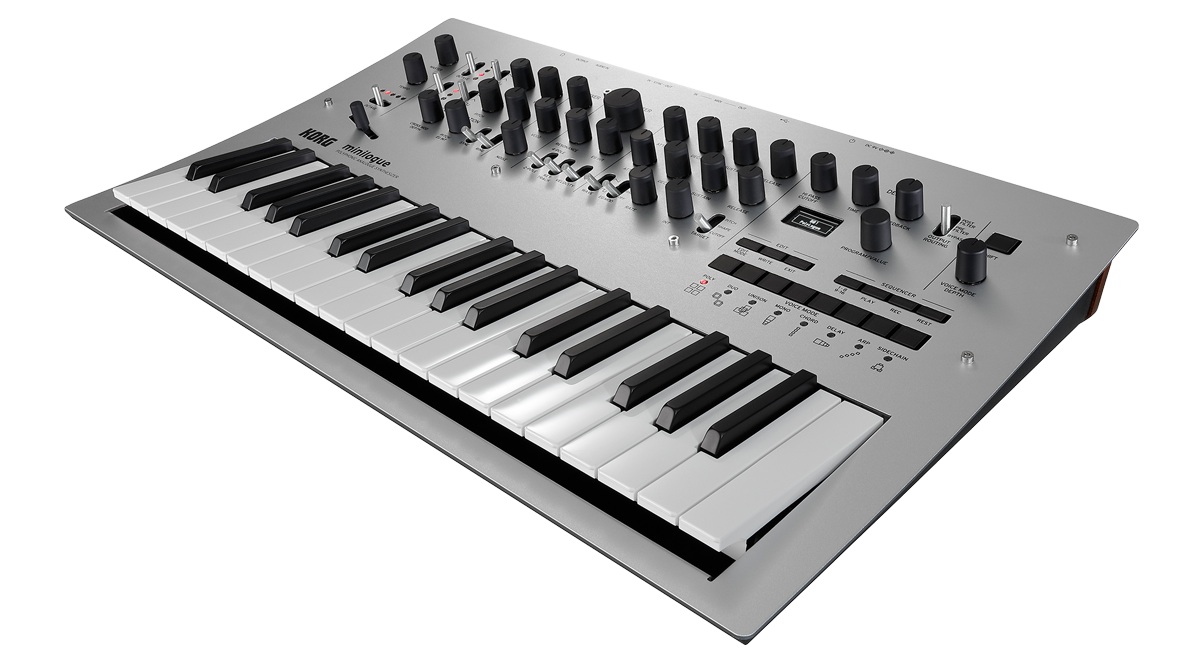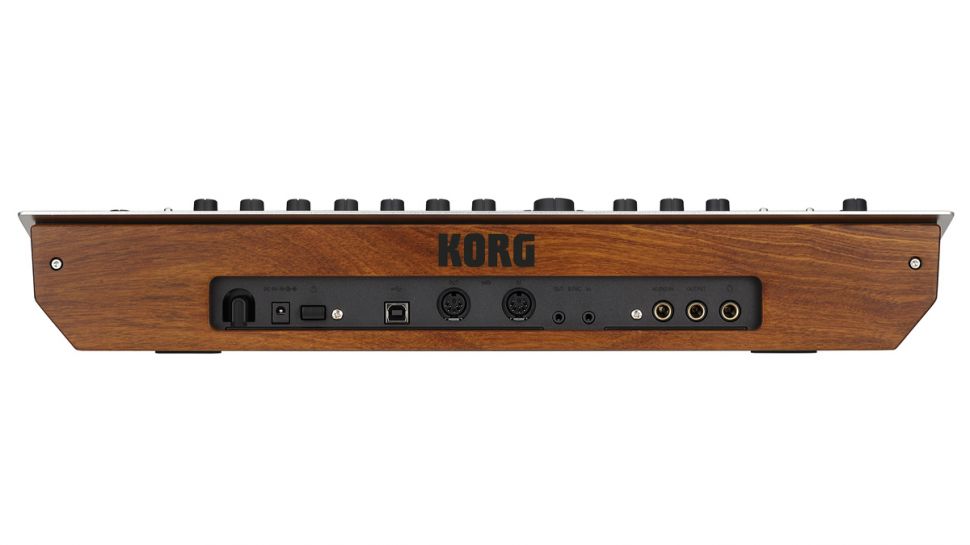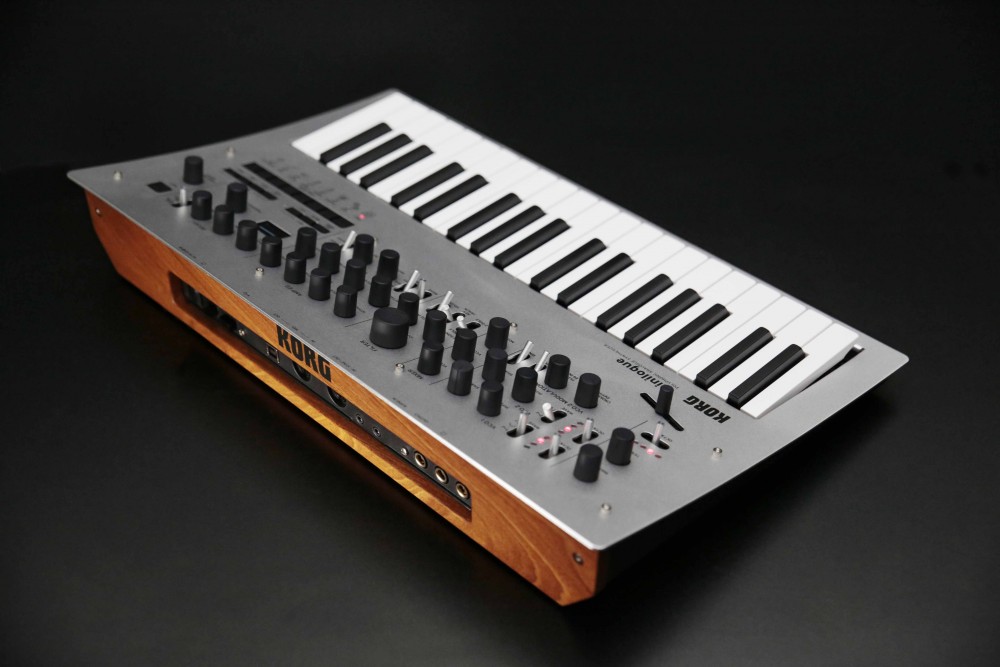Gear Review: Korg Minilogue
The Japanese powerhouse continues its run of affordable analog synths.

Korg continues its course of developing affordable, yet fully analog and compact devices designed for live performance and studio purposes, with the Minilogue. In line with the ultra-compact Volca series and the much-praised Electribe series, Korg kicks off the year with an analog polyphonic synthesizer. With its four voices and interesting added functions, its a very exciting little synth with loads of potential.
How it looks and feels
The synth wears a slick, modern aluminium jacket, indicating that the Minilogue is, or should be seen as, something more than just another reinterpretation of a classic analog poly-synth, yet it still has hints of its ancestors with a real wooden backplate. The circuit of the synth is fully analog, with added digital functionally, such as OLED screens and an effect unit.
The big black rubber coated rotary knobs, wooden backboard, metal shaft potentiometers, and tiny OLED displays give the synth a minimalistic modern look. The sturdy housing and knobs make the synth fit to accompany you on the road, with only the raised keyboard posing durability concerns when travelling frequently. In this case design was chosen over functionality.

How it works
The interface is obviously designed for accessibility. If you have ever used a basic additive synth before, it won’t take you very long to figure out the Minilogue.
The structure is basic and familiar: two voltage controlled oscillators, one voltage controlled filter, two envelope generators, and one LFO. In addition, there are some added functions that should set the synth apart from the vintage synths that we are all so familiar with. One of those functions is the “wave shape” capability, which allows you to fine tune the oscillator’s harmonics, with the wave shape cleverly displayed on the sim-card sized OLED display (the oscilloscope).
The interface has a traditional layout, following the route of the signal from being created on the left (OSC) to being shaped, amplified, and edited towards the right. A tape-delay style delay unit sits on the far right, as well as the “mode selector,” which lets you shift between modes such as mono, poly, arpeggiator, chord hold, and step sequencer.
Step sequencer and arpeggiator
This is where it gets really interesting: the onboard 16-step sequencer has a record, playback, and overdub function, and an arpeggiator that functions with all four voices. This makes the synth very apt for jamming, as well as making it more fun to play with as a standalone unit, or in combination with a rhythm or groove box.
Memory
The synth is equipped with a memory of 200 preset locations, which lets you edit one of the 100 factory presets in real time, or gives you the chance to save your best patches in the 100 empty locations—a luxury that many analog synths don’t offer. On the back of the synth you will find a USB connector, the standard midi connectors, as well as a special sync connector that can easily be connected to Korg’s groove machines (such as a unit from the KORG Electribe, Volca series, or the SQ-1). The synth does lack a MIDI-THRU port, which you will miss if you want to link all your machines via MIDI without using a dedicated MIDI-Interface. On the whole, this adds up to a whole lot of functionality for an analog synthesizer in this price range.

How it sounds
The sound is warm, bright and controlled. The Minilogue’s low-end is impressive, from a really tight sub bass, to a deep pad or wobbly bass. It has the tightness you would expect from a modern synth, but with the warmth you would expect with a fully-analog circuit. When playing in mono mode, it has similarities in sound with the Dave Smith Mopho, but being a poly synth the Minologue offers way more, and is in the same price range.
It is incredibly versatile—with its four voices and eight function modes, you can do anything from tight mono basses to evolving pads or effect sounds. The envelope generators are very accurate and let you create sounds with no attack and very short decay, making it perfect for programming drum or percussion sounds.
Going through the factory sounds, it becomes even more apparent which market Korg were targeting. There are some very recognisable and familiar sounds skilfully pre-baked by the Korg team. References of modern house, dubstep, and Detroit come to mind. The time that the synth would come with a terrible ‘electric piano’ or ‘birds’ presets is over. These sounds are ready to be made into tracks.
In line with the whole identity of the synth, it doesn’t come as a surprise that the sounds are already very tight and efficient, and therefore likely to be efficient in your mix-down. This should help you to get a good result without a lot of precision EQing and post-production. Korg did everything to make your life easier.
The only thing the Minilogue lacks is a bit of edge—when used to less convenient analog synths from the 70s and 80s, the Korg comes off a bit clean. Compared to a similar sized Moog Prodigy or Realistic MG-1, the Minilogue suddenly sounds very decent. The oscillators are tuned perfectly, the filter is relatively modest and the whole synth is brilliantly calibrated (as to be expected from a synth produced in 2016). Unfortunately this does deduct all the unintended artefacts that make some of the old synths so interesting and unique.
It all very much depends on what you are looking for. If you are producing modern sounding dubstep or house, you can almost hardwire the synth’s output into your computer. If you are looking for a more dusty, organic sound with irregularities, you might have to run your signal through some pre-amps or tape delays, to give some edge to it. The great thing about this synth is that it has the potential to do both. And with the added wave shape function, as well as several modulating functions (such as the ring modulator), you can even give your sounds a little bit of that edge within the synth.
The bottom line
That Korg lends one ear to the street was already proven with the products released in the previous years. For the ever-growing league of semi-professional bedroom producers seeking the best sound and most functionality out of their hard-earned money, the Minilogue is a perfect fit. Where for the Volca series Korg had to compromise a few too many basic functions (making the units as small and affordable as they are), they have now found the perfect balance between price, sound, and size with the Minilogue. It can compete with synths double its price, both in sound, building quality, and functionality.
Don’t expect a synth that is going to shape your sounds or set you apart from other producers. The unique sound of the machine is not designed for that. What you can expect is a great sounding, incredibly functional, and rugged synth. Learn every function, and you will be able to get that individuality out of it.
Price: $500

